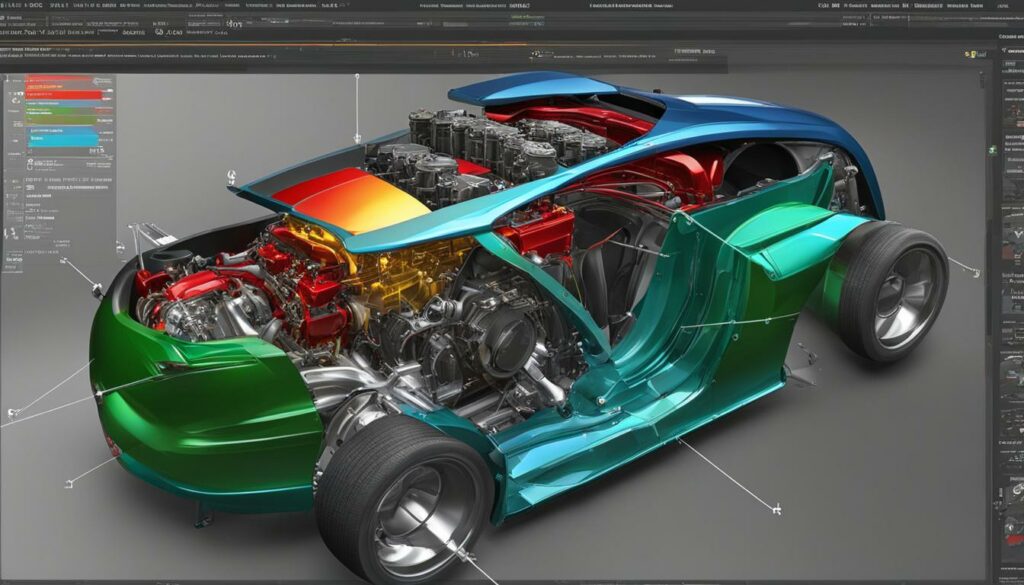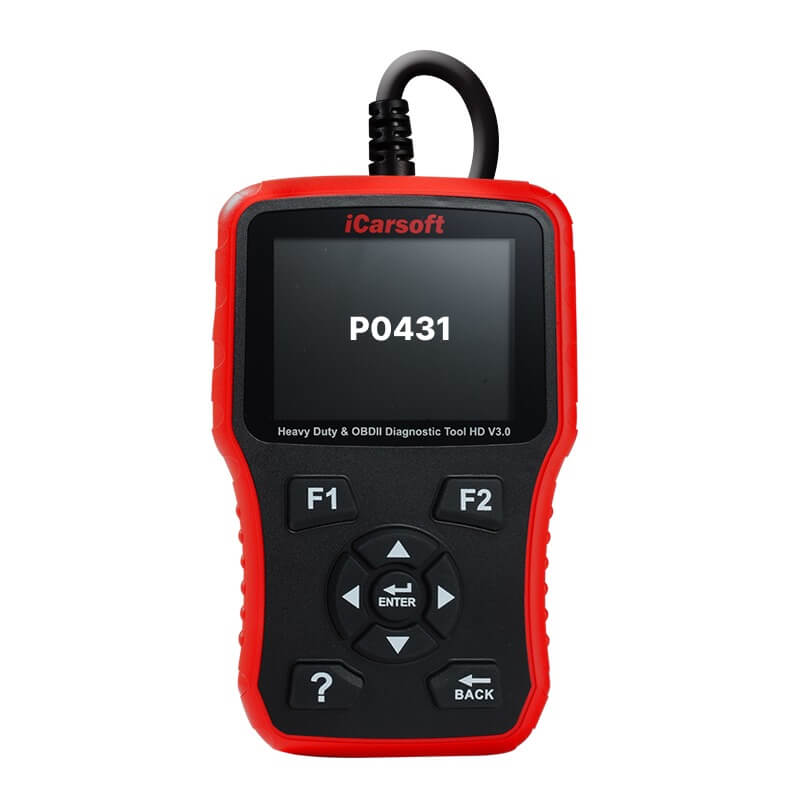P0431 – Warm Up Catalyst Efficiency Below Threshold Bank 2
POSTED IN pcodes
Are you experiencing decreased fuel efficiency and engine performance in your vehicle? The P0431 engine code may be the culprit. This code, also known as “Warm Up Catalyst Efficiency Below Threshold Bank 2,” is triggered when the catalytic converter fails to meet the efficiency standards set by the manufacturer. It’s essential to address this issue promptly to ensure optimal vehicle performance and reduce harmful emissions.
Key Takeaways:
- The P0431 code indicates a problem with the warm up catalytic converter on Bank 2.
- Possible triggers for the code include a faulty catalytic converter, oxygen sensor, or exhaust leak.
- Symptoms of the P0431 code may include diminished fuel efficiency and decreased engine performance.
- Diagnosing and fixing the P0431 code requires professional expertise and proper troubleshooting techniques.
- Timely diagnosis and repair are crucial to maintain optimal vehicle performance and emissions control.
What Does the P0431 Code Mean?
Diagnostic trouble code (DTC) P0431 refers to the “Warm Up Catalytic Converter, Bank 2—Efficiency Below Threshold.” This code is triggered when the primary computer or powertrain control module (PCM) of your car detects that the catalytic converter on bank 2 is not operating efficiently according to the factory specifications.
The catalytic converter is an essential component of your vehicle’s exhaust system. Its main function is to convert harmful pollutants in the exhaust gases into less harmful substances before they are released into the environment. The efficiency of the catalytic converter is monitored using upstream and downstream oxygen sensors. The upstream sensor measures the oxygen content in the exhaust gases before they enter the catalytic converter, while the downstream sensor measures the oxygen content after the gases have passed through the converter.
The PCM compares the readings from the upstream and downstream sensors to determine the efficiency of the catalytic converter. If the readings from the upstream and downstream sensors on bank 2 are similar, indicating a low oxygen reduction, the PCM will store the P0431 code.
It’s important to address this code promptly as an inefficient catalytic converter can lead to increased emissions, reduced fuel efficiency, and decreased engine performance. Let’s explore the possible causes of the P0431 code in the next section.
Buy tested tuning file for Adblue / EGR / DPF / Adblue off now!
Example Mechanic’s Expertise
“Understanding the meaning behind diagnostic trouble codes like P0431 is crucial in identifying and resolving vehicle issues. The P0431 code specifically points to an efficiency problem with the catalytic converter on bank 2. By analyzing the data from upstream and downstream oxygen sensors, we can determine the level of oxygen reduction and take the necessary steps to rectify the issue, whether it’s replacing a faulty sensor, repairing an exhaust leak, or replacing the catalytic converter itself.”
– John Smith, Certified Mechanic at ABC Auto Clinic
Possible Causes of the P0431 Code
The P0431 code is triggered when the warm-up catalytic converter on Bank 2 fails to meet the required efficiency threshold. There are several common causes for this code:
- A malfunctioning catalytic converter: A worn-out or damaged catalytic converter can restrict exhaust flow and result in decreased efficiency.
- A faulty oxygen sensor: The oxygen sensor measures the oxygen level in the exhaust gases and provides feedback to the engine control module. A faulty sensor can cause inaccurate readings and trigger the P0431 code.
- An exhaust leak: Any leak in the exhaust system, such as a cracked or damaged exhaust manifold, can lead to a decrease in catalytic converter efficiency and trigger the code.
It is important to address these issues promptly to prevent further damage to the catalytic converter and ensure optimal engine performance.

| Common Causes of P0431 Code |
|---|
| Malfunctioning catalytic converter |
| Faulty oxygen sensor |
| Exhaust leak |
Symptoms of the P0431 Code
When your vehicle displays the P0431 code, there are several symptoms that you may notice. These symptoms are indicative of a problem with the catalytic converter’s efficiency.
One of the common symptoms associated with the P0431 code is diminished fuel efficiency. You may find that your vehicle is not delivering the same level of fuel economy as before. This can result in increased fuel consumption and higher costs at the gas pump.
Furthermore, decreased engine performance is another symptom of the P0431 code. Your engine may not produce the same amount of power or acceleration as it used to. This can affect your overall driving experience and make it more difficult to reach highway speeds or climb steep hills.
“The symptoms of the P0431 code may include diminished fuel efficiency and decreased engine performance.”
In addition to the above symptoms, the check engine light may also illuminate on the dashboard. This is the vehicle’s way of alerting you to a potential issue. If you notice this warning light, it’s important to address the problem as soon as possible to prevent further damage to the catalytic converter or other components of the exhaust system.
Identifying and addressing these symptoms promptly is crucial to maintaining the performance and efficiency of your vehicle. In the next section, we will discuss the diagnostic steps involved in pinpointing the cause of the P0431 code.
Diagnosing the P0431 Code
When faced with the P0431 code, it is important to follow a systematic diagnostic approach to accurately identify the underlying issue. While advanced troubleshooting requires specialized tools and expertise, there are some initial steps you can take to diagnose the problem:
- Inspect for exhaust leaks: Begin by visually examining the exhaust system for any visible leaks or damage. Leaks can greatly affect the efficiency of the catalytic converter and trigger the P0431 code.
- Check the voltage of the oxygen sensors: Oxygen sensors play a crucial role in monitoring the catalytic converter’s efficiency. Use a multimeter to measure the voltage output of both the upstream and downstream oxygen sensors. Any significant deviation from the expected values indicates sensor malfunction.
- Test the catalytic converter: Conducting a diagnostic test specifically targeting the catalytic converter can provide valuable insights. One common method involves using a scanner tool to monitor the live data and observe the oxygen sensor’s response to changes in engine conditions.
While these troubleshooting steps offer a starting point, it is crucial to consult a certified mechanic or automotive professional for an accurate diagnosis. Their expertise and specialized equipment can pinpoint the exact cause of the P0431 code, preventing unnecessary repairs and costs.

Remember, diagnosing and resolving the P0431 code promptly is essential to maintain optimal vehicle performance and ensure compliance with emission regulations.
Fixing the P0431 Code
Fixing the P0431 code will depend on the specific cause of the issue. It may involve repairing exhaust leaks, replacing faulty oxygen sensors, or replacing the catalytic converter. If the code is triggered by an exhaust leak, repairing the leak and ensuring proper sealing can rectify the problem. If the oxygen sensors are faulty, they will need to be replaced to accurately monitor and adjust the catalytic converter’s efficiency.
Replacing the catalytic converter is another potential solution for fixing the P0431 code. If the converter is damaged or worn out, it may be unable to perform its function effectively. In such cases, replacing the catalytic converter can restore its efficiency and resolve the code.
It is important to note that diagnosing and fixing the P0431 code may require specialized tools and knowledge. If you are not confident in your DIY skills, it is recommended to seek the assistance of a qualified professional. They have the expertise and experience to accurately diagnose the issue and perform the necessary repairs, ensuring your vehicle’s optimal performance and emissions control.
| Possible Fixing Methods | Description |
|---|---|
| Repairing Exhaust Leaks | Exhaust leaks can disrupt the proper functioning of the catalytic converter. Repairing the leaks and ensuring a secure seal can help restore efficient operation. |
| Replacing Faulty Oxygen Sensors | If the oxygen sensors are malfunctioning, they may inaccurately measure the catalytic converter’s efficiency. Replacing these sensors can provide accurate readings and correct the issue. |
| Replacing the Catalytic Converter | If the catalytic converter is damaged or worn out, replacing it can restore its ability to efficiently reduce emissions and eliminate the P0431 code. |
Conclusion
In summary, the P0431 code indicates that the warm up catalytic converter on Bank 2 is not operating efficiently. This technical description refers to the performance of the catalytic converter, which is responsible for reducing harmful emissions in the exhaust system. When the converter fails to meet the threshold of efficiency set by the manufacturer, the P0431 code is triggered.
There are several potential causes for this code, including a malfunctioning catalytic converter, faulty oxygen sensors, or an exhaust leak. These issues can disrupt the proper functioning of the catalytic converter, leading to decreased fuel efficiency and engine performance. It’s important to address the P0431 code promptly to avoid further damage and ensure compliance with emissions regulations.
To resolve the P0431 code, a comprehensive diagnosis is necessary. This involves inspecting the exhaust system for leaks, testing the voltage of the oxygen sensors, and evaluating the functionality of the catalytic converter. Depending on the specific issue identified, repairs may involve fixing exhaust leaks, replacing faulty sensors, or installing a new catalytic converter. To ensure the job is done correctly, it is recommended to consult a certified mechanic with experience in diagnosing and repairing catalytic converter issues.
FAQ
What does the P0431 code mean?
The P0431 code stands for “Warm Up Catalytic Converter, Bank 2—Efficiency Below Threshold.” It means that the catalytic converter on Bank 2 of your vehicle is not operating efficiently according to factory specifications.
What are some possible causes of the P0431 code?
The common causes of the P0431 code include a malfunctioning catalytic converter, a faulty oxygen sensor, and an exhaust leak.
What are the symptoms of the P0431 code?
Symptoms of the P0431 code may include diminished fuel efficiency and decreased engine performance. The check engine light may also illuminate on the dashboard.
How is the P0431 code diagnosed?
Diagnosing the P0431 code may involve inspecting for exhaust leaks, checking the voltage of the oxygen sensors, and testing the catalytic converter. It is recommended to seek the help of a certified mechanic for an accurate diagnosis.
How can I fix the P0431 code?
Fixing the P0431 code will depend on the specific cause of the issue. It may involve repairing exhaust leaks, replacing faulty oxygen sensors, or replacing the catalytic converter. It is recommended to let professionals handle the job if you are not confident in your DIY skills.


